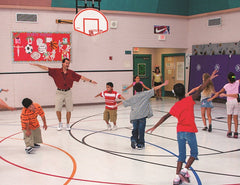Movement Skills and Concepts
By Dr. Robert Pangrazi, Human Kinetics Author, Professor Emeritus ASU
MAY 2019
Enthusiasm is essential when teaching youngsters movement concepts. Smiles, voice inflections, noises, and so on will serve you well. Consider the following instructions: "Can you walk like a bear?" versus "Oh, I have a great idea. First grade, can you walk like this animal I saw in the mountains last summer? Make sure you make their noise... Wow! Listen to these bears!" Little bits of creativity and imagination will bring these experiences alive for children. (Teaching tip taken from Dynamic Physical Education for Elementary School Children-19th Edition.)
Below are ideas and lesson plans that emphasize skill development. For Grades K-2, sliding and galloping skills are practiced by using many variations. The "Movement Skills and Concepts" lessons are found throughout the K-2 yearly curriculum and they all have a similar format. Activities are organized into 4-5 groups in each lesson. For example, in the lesson this week, there are the following groups: Fundamental Skills: Sliding, Fundamental Skills: Galloping, Manipulative Skills: Hoop Activities, and Movement Concepts: Movement Combinations. The groupings make it easy to select a few activities from each of the categories, ensuring that students practice a variety of skills. This also helps prevent boredom because of excessive time focused on one skill.
The lessons for Grades 3-8 focus on throwing skills. The throwing motion is one of the most important skills to learn since many sports involve throwing or accelerating a racket. The throwing lesson concentrates on three parts. Part one reviews proper throwing form and offers many repetitions of throwing different projectiles. Part two offers the chance to throw with maximum velocity (which is necessary to learn to coordinate levers and generate force). Part three involves throwing at targets to maintain motivation. When students are throwing at targets, emphasis should be on throwing with force rather than accuracy.
 Bob Pangrazi, PhD, taught for 31 years at Arizona State University in the department of exercise science and physical education and is now a professor emeritus. He is a best-selling author of numerous books and texts over the years, including multiple editions of Dynamic Physical Education for Elementary School Children. This text is made even more practical in release of the 19th edition with the free interactive website Dynamic PE ASAP.
Bob Pangrazi, PhD, taught for 31 years at Arizona State University in the department of exercise science and physical education and is now a professor emeritus. He is a best-selling author of numerous books and texts over the years, including multiple editions of Dynamic Physical Education for Elementary School Children. This text is made even more practical in release of the 19th edition with the free interactive website Dynamic PE ASAP.

Latest Posts
- Live Well: Middle School Health Correlations to National and State Standards
- Review of Adapted Physical Activity Across the Life Span
- Supporting Mental Health through Movement
- Review of Promoting Elementary School Physical Activity
- Human Kinetics Acquires PE Central Online School
- School-Based Promotion of Children's Physical Activity


